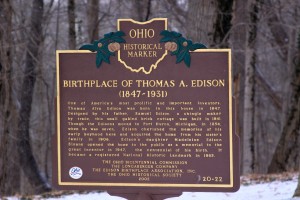 As readers must know by now from past blog posts, our family loves to travel! So, after a trip to Cleveland, Ohio to see the Rock and Roll Hall of Fame, we decided to take a different route home.
As readers must know by now from past blog posts, our family loves to travel! So, after a trip to Cleveland, Ohio to see the Rock and Roll Hall of Fame, we decided to take a different route home.
Checking to see what places of interest were in the area, we found Thomas Edison’s Boyhood Home in Milan, Ohio. The small brick home with the white picket fence was built in 1842. Edison spent his early childhood years there until his parents sold the home in 1854 and moved to Port Huron, Michigan. Edison loved his childhood home so much that in 1906 he purchased the home from his sister’s family. The Thomas Edison Birthplace was opened to the public in 1947 and became a registered as a National Historic Landmark in 1965.
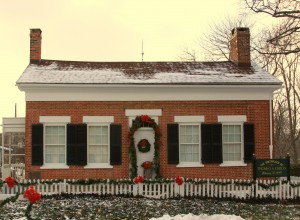
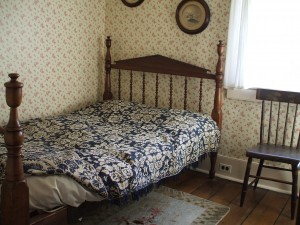
Visitors start their tour at the small museum next to the house. The museum is filled with Edison’s inventions and the docent gave a wonderful presentation on the life of Thomas Edison. There were four different age groups on this trip; my husband and I, our son, daughter and my husband’s father. There was enough information, several different types of inventions and various displays to keep everyone interested. The docent also gave a very detailed tour of Edison’s house and explained life in Ohio in the late 1800s.
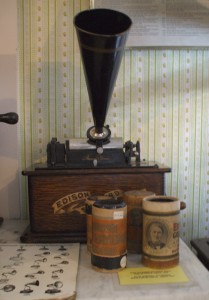
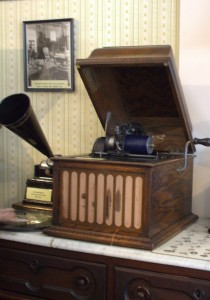
When planning a visit to Milan, Ohio it is worth a visit to the Thomas Edison Birthplace Historic Site. For more travel information, please refer to the web site for the Thomas Edison Birthplace Museum.
The life of Thomas Edison
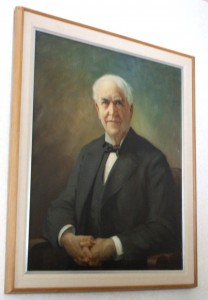 Thomas Alva Edison (Born: February 11, 1847 Died: October 18, 1931) was an American inventor. He developed numerous inventions and registered 1,093 patents during his life but the incandescent light bulb was his most famous invention. Edison’s inventions greatly influenced our daily lives with modern conveniences such as indoor light, power, heat, music and movies.
Thomas Alva Edison (Born: February 11, 1847 Died: October 18, 1931) was an American inventor. He developed numerous inventions and registered 1,093 patents during his life but the incandescent light bulb was his most famous invention. Edison’s inventions greatly influenced our daily lives with modern conveniences such as indoor light, power, heat, music and movies.
Edison was born in Milan, Ohio and the family later moved to Port Huron, Michigan in 1854. As a young man, Edison sold candy and vegetables on the Grand Trunk train route from Port Huron to Detroit. Eventually he saw an opportunity to use the news and information gained along his route. Edison obtained the exclusive rights from the Grand Trunk Railroad to write, print and sell his own newspaper, The Grand Trunk Herald. In 1866, Edison took a job as a telegraph operator for Western Union and moved to Louisville, Kentucky. He had requested the night shift so he could have time to read the books he loved and to perform the simple experiments that fascinated him. One year later, one of those experiments went horribly wrong and he was fired from Western Union.
Edison moved to Newark, New Jersey and began his career as an inventor. He continued with his experiments and developed improvements on several telegraphic devices. Ironically after selling his invention, the quadruplex telegraph, to Western Union for $10,000 Edison was able to build his industrial research lab in Menlo Park, New Jersey. Menlo Park became the first institution dedicated to the specific purpose of research and development of technological improvements and inventions. Under Edison’s direction, his staff of engineers performed experiments with the telephone, the phonograph, an electric railway system and other developing inventions. Edison proved to be one of America’s greatest inventors and has registered over a thousand patents including his most famous one, the incandescent light bulb. With all these accomplishments, Edison became known as “The Wizard of Menlo Park”.
Thomas Edison died at his home from diabetes complications in 1931 and is buried at “Glenmont” in West Orange, New Jersey.
Interesting facts about Edison
- In 1878, Edison formed the Edison Electric Light Company in New York City with several financiers, including J.P. Morgan and members of the Vanderbilt family. This was only one of fourteen companies that entrepreneur and successful businessman Thomas Edison would own over the years.
- In 1881 Lewis Latimer, an African-American inventor, patented the “Process of Manufacturing Carbons”. For this reason, he was hired by the Edison Electric Light Company in 1884 as a draftsman and expert witness in patent litigation. His patented invention of the carbon filament was a great improvement on Edison’s original paper filament which proved to burn out too quickly.
- In 1882, Nikola Tesla worked at the Continental Edison Company in France for two years before immigrating to America. In 1884, he worked at the Edison Machine Works in New York for one year. Eventually his employment with Edison was terminated over a disagreement regarding salary. Later, with the help of major financial backers, Tesla set up his own lab to develop electrical devices. He patented the AC induction motor and transformer which were quickly licensed by George Westinghouse, Edison’s competitor. Westinghouse hired Tesla as a consultant to help develop an alternating current AC system for his company.
- Edison (who used the limited direct current or DC) and Westinghouse (with the more easily transmitted alternating current or AC) became fierce competitors for the lucrative new business of electrical power distribution. Strangely, Edison became involved in the development and promotion of the electric chair which used AC. In Edison’s campaign of publicly staging electrocutions of stray or unwanted animals, he wanted to prove to the world that AC was more dangerous and lethal than DC. With these controversial demonstrations, Edison hoped to have the allowable voltage of AC severely limited or banned entirely from use which would ultimately result in his company’s continued dominance of the profitable electrical power distribution market.
- Henry Ford, a close friend, had convinced Thomas Edison to dismantle, re-locate and re-construct the two buildings that were Edison’s research and technology development lab that originally were located in Menlo Park, New Jersey. Ford wanted to preserve it for future generations to view exactly how this important and innovative laboratory looked in 1879 at the time of his greatest invention. Known as the Edison Institute, it was dedicated on October 21, 1929 in Dearborn, Michigan as a celebration of the 50th anniversary of the first successful incandescent light bulb. Some of the 260 people in attendance that day were Thomas Edison, Henry Ford, President Herbert Hoover, Marie Curie, George Eastman, John D. Rockefeller, and Orville Wright. Eventually, the Institute was renamed the Henry Ford Museum after Ford’s death in 1947 and is one of the largest museums in the country.
- Shortly after Thomas Edison’s death in 1931, Henry Ford convinced Edison’s family to seal into a test tube the air in the room that Edison had just died in. Edison’s “last breath” is reportedly contained in this test tube displayed at the Henry Ford Museum in Dearborn, Michigan. (If you are interested in more information about the Henry Ford Museum, please see the January Travel Post regarding our family’s trip to Dearborn, Michigan)
